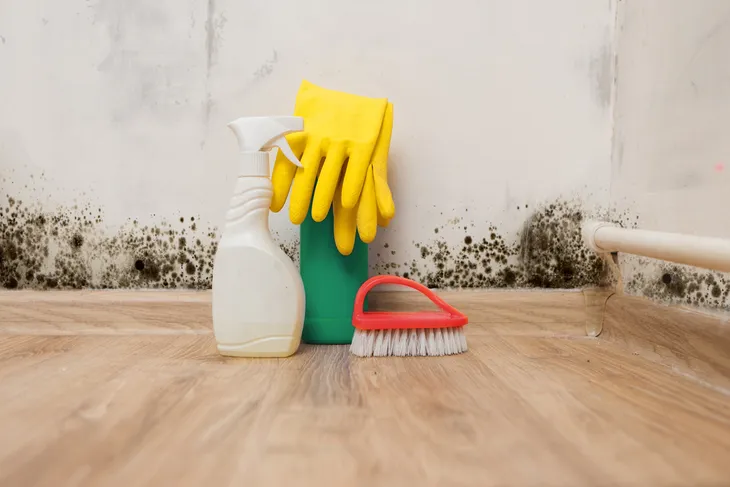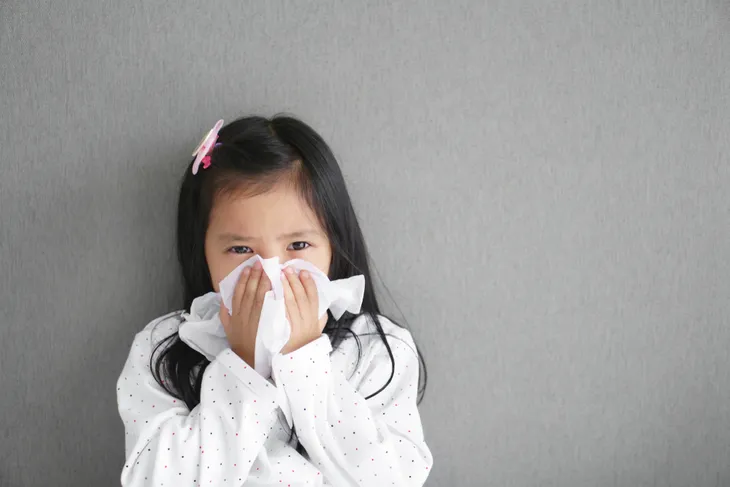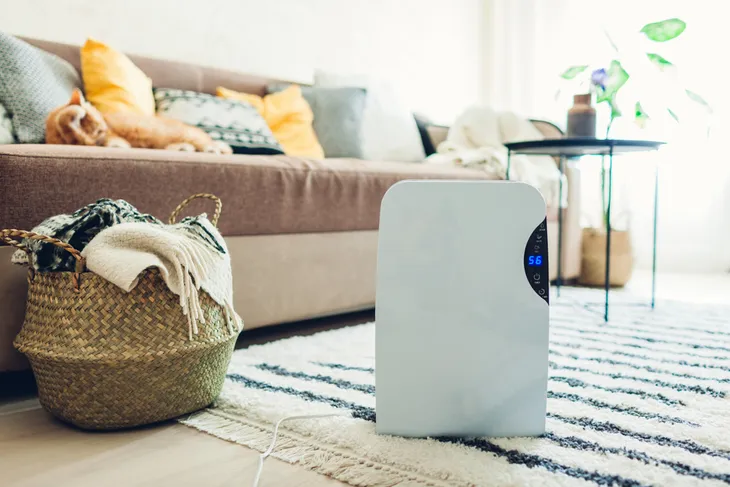- A mold allergy occurs when your immune system overreacts when you breathe in mold spores.
- Telltale signs of a mold allergy include itchy eyes, coughing, and sneezing.
- Symptoms can be miserable but there are treatment options available and prevention steps you can take to help manage your symptoms.
Coughing, sneezing, and congestion, sound familiar? These could all be vital signs that you’re suffering from a mold allergy. It’s a lot more common than you may think too. The Cleveland Clinic states that 1 in 5 people in the United States has environmental allergies, which include mold.
Sometimes symptoms of a mold allergy can be so severe people have to miss work. They can also interfere with their quality of life too. While there is no cure, there are treatment options available to help you manage the symptoms. Here’s everything you need to know about a mold allergy.
What Is a Mold Allergy?
Mold is a type of fungus that can grow on almost anything. And it grows both indoors and outdoors. It thrives in moist and damp environments and produces spores that drift through the air. According to the Asthma and Allergy Foundation of America (AAFA), it’s also the most common cause of allergy and asthma symptoms.
Since mold spores can float in the air, it’s easy to inhale them and sometimes they cause an allergic reaction in some people. This is known as a mold allergy. The source also notes that allergic symptoms are most common from July to early fall but since mold can grow both indoors and outdoors, allergic reactions can happen all year round.
Types of Molds That Cause Allergies
There are many different types of molds but not all cause allergy symptoms. The AAFA says the most common types of molds that cause allergies include:
- Alternaria
- Aspergillus
- Cladosporium
- Penicillium
The Cleveland Clinic also points out that you can be allergic to molds in foods, including mushrooms, certain types of cheese, fermented foods, and some wines and foods that contain vinegar. Additionally, you should be aware of toxic molds like Stachybotrys, also known as black mold. This type can cause very serious illnesses.
Common Symptoms of Mold Allergies
It’s easy to mistake a mold allergy for the common cold as symptoms are often similar. Symptoms of a mold allergy often include sneezing, coughing, and congestion. It’s also common to experience watery and itchy eyes which isn’t normal for colds so this symptom can help you distinguish between whether you have a cold or allergies. Postnasal drip is a common symptom too.
Additionally, if you have asthma and a mold allergy, your asthma symptoms may get worse when you’re exposed to mold. Telltale signs of asthma include coughing, chest tightness, and difficulty breathing. It’s also common to develop wheezing when you’re having an asthma attack. If you develop severe symptoms (such as difficulty breathing and wheezing) seek medical attention right away.
What to Know About Mold Allergies in Children
Children can develop mold allergies too. If your child is the only one to develop symptoms it is possible that they’re the only one in the family with a sensitivity to mold, explains Healthline. However, they can also be exposed in other areas such as in their school or on the playground.
Children often spend a lot of time playing outdoors which can also expose your child to mold. The source says, “Children with asthma may experience more attacks while playing outside for this reason.”
What Causes a Mold Allergy?
So, why do some people develop an allergy to mold while others do not? The Mayo Clinic says it all comes down to an overly sensitive immune system response. The source explains, “When you inhale tiny, airborne mold spores, your body recognizes them as foreign invaders and develops allergy-causing antibodies to fight them.”
The source also says sometimes reactions can develop after you’ve been exposed to mold while other times the reaction may be delayed. It’s also possible to be allergic to one type of mold but not another.
Possible Risk Factors
Certain factors can increase your risk of developing a mold allergy, such as having a family history of allergies. If one of your family members has allergies or asthma, then it’s more likely that you’ll develop it too.
The Mayo Clinic says working in an environment that exposes you to mold (such as farming, logging, baking, and carpentry) can also increase your risk. If your indoor humidity is higher than 50-percent, your risk of mold exposure is greatly increased, and therefore, so is your risk of developing an allergy. Finally, living in a home that’s been exposed to excess moisture or a home that has poor ventilation can also increase your risk of developing a mold allergy.
Is Mold Toxic?
Many people believe that all mold is toxic and can cause permanent damage. But the reality is not everyone has a reaction to mold. Some people can develop symptoms after exposure while others do not.
Exposure to mold can also cause asthma symptoms to worsen, however, Healthline emphasizes that mold exposure does not cause asthma. Furthermore, prolonged inhalation of certain types of mold can lead to a serious (but rare) condition known as hypersensitivity pneumonitis. Let’s take a look at this condition next.
Complications of Hypersensitivity Pneumonitis
Hypersensitivity pneumonitis is a condition that develops after prolonged exposure to mold spores. Healthline says one of the common types of HP is farmer’s lung. This type is common in farmers who breathe in mold spores that grow in straw, hay, and grain.
The source points out that unfortunately it often goes undiagnosed, which can lead to permanent damage, like scar tissue on the lung. Scar tissue on the lung is known as fibrosis which is serious because it can lead to difficulty breathing. Farmer’s lung can also become chronic which can lead to more serious symptoms than an allergic reaction, such as shortness of breath, fever, chills, and a dry cough. Contact your doctor if you develop any of these symptoms.
Other Complications
While most allergy symptoms can be incredibly annoying and make you feel horrible, they aren’t usually serious. That said, along with hypersensitivity pneumonitis, the Mayo Clinic says there are a few other serious conditions you should be aware of.
For starters, mold-induced asthma can cause a severe asthma attack which can be a medical emergency. The source suggests having an emergency plan in place in case a severe asthma attack develops. Other serious complications include allergic fungal sinusitis and allergic bronchopulmonary aspergillosis. If you are allergic to mold and have asthma, or cystic fibrosis or are just concerned about your risk for complications, talk to your doctor.
 Shutterstock/Dragana Gordic
Shutterstock/Dragana GordicHow Is a Mold Allergy Diagnosed?
If you develop symptoms of a mold allergy, contact your doctor for a proper diagnosis. They’ll likely start by reviewing your medical history and current symptoms as well as a physical exam to rule out other medical conditions.
The Mayo Clinic says to confirm a diagnosis your doctor may recommend a skin prick test. This test uses “diluted amounts of common or suspected allergens, such as molds,” and applies the substances to the skin on your arm or back with tiny punctures. If you are allergic a small bump will develop on the skin.
Your doctor may also recommend a blood test to “measure your immune system’s response to mold,” explains the source. This is done by measuring immunoglobulin E (IgE) antibodies in your bloodstream.
How to Treat Mold Allergies
The Mayo Clinic says the best way to manage a mold allergy is to avoid exposure to mold spores but it’s not always possible to completely avoid it. Luckily there are treatment options available that can help you manage the allergy.
Some of the most common forms of treatment for a mold allergy include nasal sprays and allergy medication. In some cases, your doctor may recommend immunotherapy. It’s important to follow the guidance of your doctor to find out which treatment option is best for you.
Prevention and Home Remedies
There are simple things you can do at home to help reduce mold growth and to help manage your symptoms. For starters, to keep outdoor mold out of your home, always sleep with your windows closed. You should also aim to keep your indoor humidity below 50-percent. A simple way to do this is by using a dehumidifier.
You can also reduce your exposure to mold by running the air conditioner instead of opening windows. The best air conditioner is one that has a high-efficiency particulate air (HEPA) filter attachment. This filter can trap mold spores before they circulate in your home. You should also change your furnace filters regularly and ensure your bathrooms are properly ventilated.
Finally, it’s also a good idea to avoid going outdoors when the mold count is high. You can also reduce your exposure by avoiding the outdoors when it’s foggy or damp, or immediately after a rainstorm.














